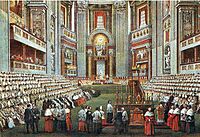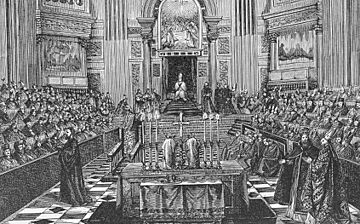First Vatican Council facts for kids
Quick facts for kids First Vatican Council |
|
|---|---|
 |
|
| Date | 8 December 1869 – 20 September 1870 (de facto) 8 December 1869 – 5 June 1960 (de jure) |
| Accepted by | Catholic Church |
|
Previous council
|
Council of Trent (1545–1563) |
|
Next council
|
Second Vatican Council (1962–1965) |
| Convoked by | Pope Pius IX |
| President | Pope Pius IX |
| Attendance | 744 |
| Topics | Rationalism, liberalism, materialism; biblical inspiration; papal infallibility |
|
Documents and statements
|
Two constitutions:
|
| Chronological list of ecumenical councils | |
The First Vatican Council, also known as Vatican I, was a very important meeting of leaders from the Catholic Church. It was the 20th such meeting, called an ecumenical council. It happened about 300 years after the previous big council, the Council of Trent.
Pope Pius IX called for this council on 29 June 1868. He did this because the Kingdom of Italy was growing stronger and threatening the Papal States, which were lands ruled by the Pope. The council started on 8 December 1869 and ended on 20 September 1870. It stopped when Italian forces took over Rome.
One of the most famous decisions from this council was defining the idea of papal infallibility. This means that the Pope cannot be wrong when he speaks officially about faith or morals.
The main goal of the council was to make Catholic teachings clearer. This was important because new ideas in philosophy were becoming popular in the 1800s. In a document called Dei Filius, the council spoke against ideas like rationalism (only reason matters), liberalism (focus on individual freedom), and materialism (only physical things exist).
Another key topic was the Pope's special authority and his infallibility. This was explained in another important document called Pastor aeternus.
Contents
Why the Council Was Called
As early as 1864, Pope Pius IX asked his top advisors, the cardinals, if they thought a council was a good idea. Most of them agreed it was. By March 1865, it was clear the council would happen.
The Pope officially called the council on 29 June 1868. The first meeting took place in St. Peter's Basilica on 8 December 1869. Early meetings were about setting up rules and assigning tasks.
Unlike five earlier councils held in Rome at the Lateran Basilica, this one met in Saint Peter's Basilica in the Vatican. That's why it's called the Vatican Council.
Understanding Papal Infallibility
For a while, no one was sure what the council would focus on. Then, in February 1869, a Jesuit magazine hinted that the council would be short. It suggested that many church leaders agreed on defining papal infallibility. This idea caused some debate across Europe.
Pope Pius IX had already declared a belief about Mary, the mother of Jesus, as a dogma in 1854. However, making papal infallibility an official dogma faced some opposition. Not because people doubted the idea itself, but because some thought it wasn't the right time to do it.
Historians often divide the bishops at Vatican I into three groups:
- Strong supporters: These bishops really wanted to define papal infallibility.
- Majority: Most bishops wanted to make the Pope's authority stronger. They were willing to support the idea of infallibility for this reason.
- Opponents: About 10% of the bishops were against defining infallibility. They worried it would change the Church's structure from early Christian times. They also feared it might upset some Catholics, make it harder to unite with non-Catholics, and cause problems with governments.
Most of the German and Austro-Hungarian bishops, nearly half of the Americans, and many others were in the opposing group. Only a few bishops actually doubted the idea of infallibility itself.
Dei Filius: On Catholic Faith
On 24 April 1870, a document called Dei Filius was approved by everyone. This document explained the Catholic faith. It talked about God, how God reveals himself, and the importance of faith.
There was a small change made to the document. A group of English-speaking bishops worried that the original phrase "Holy Roman Catholic Church" might be misunderstood. So, they successfully added another word, making it "Holy Catholic Apostolic Roman Church" in the final text.
Pastor aeternus: On the Pope's Authority
There was more disagreement about the document on the nature of the Church, especially when the topic of papal infallibility was added. The majority of the council members strongly supported this idea and pushed it forward. They decided to focus only on infallibility for a while.
The decree was not passed without debate. One cardinal suggested that the Pope should get advice from bishops who represent the traditions of different churches. However, Pope Pius IX disagreed, saying, "I am the tradition."
On 13 July 1870, a test vote was held on the infallibility section:
- 451 bishops voted simply "yes" (placet).
- 88 voted "no" (non placet).
- 62 voted "yes, with changes" (placet iuxta modum).
This vote showed what the final result would be. About 60 bishops who opposed the idea left Rome so they wouldn't have to vote for it. The final vote happened on 18 July 1870. This time, there were only two choices: "yes" or "no." 533 bishops voted "yes," and only 2 voted "no." These two were Bishops Aloisio Riccio and Edward Fitzgerald.
The document states that the Pope has "full and supreme power" over the whole Church. It also says that when he speaks ex cathedra (meaning, in his official role as shepherd and teacher of all Christians, defining a doctrine about faith or morals for the whole Church), he has a special gift from God. This gift means he cannot be wrong in those specific teachings.
None of the bishops who had argued against defining infallibility at that time refused to accept it after the vote. However, some Catholics, mostly in Germany, formed a separate group called the Old Catholic Church because they disagreed with this new dogma.
Council Ends and What Happened Next
The bishops were supposed to continue discussing other parts of the Church document after a summer break. But then, the Franco-Prussian War began. French troops, who were protecting the Pope's rule in Rome, had to leave the city to fight in the war.
On 20 October 1870, a month after the new Kingdom of Italy took over Rome, Pope Pius IX stopped the council indefinitely. He considered himself a prisoner in the Vatican at this time. Although some suggested continuing the council in Belgium, it never met again. The council was officially closed in 1960 by Pope John XXIII, just before the start of the Second Vatican Council.
The definition of papal infallibility had big effects on countries in Europe. Some governments worried about the Pope's increased power. For example, the Austrian Empire ended its agreement with the Catholic Church. In Prussia, a period of conflict called the Kulturkampf began, where the government tried to control the Church. In France, the government eventually separated the Church from the state completely.
See also



